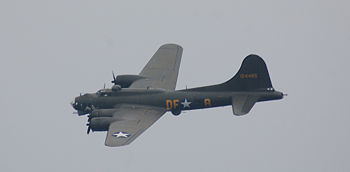Talk:Boeing B-17 Flying Fortress
My favorite plane of all time. Can't wait to see a picture. --Matt Innis (Talk) 21:22, 17 October 2007 (CDT)
- Haha, the majic of collaboration! Gotta love it:-) --Matt Innis (Talk) 22:46, 17 October 2007 (CDT)
- When do we get to see the B29? --Matt Innis (Talk) 22:50, 17 October 2007 (CDT)
title change?
I just added the B-29 article. I suggest we change the title to B-17 (with "flying fortress" as a link). There is no need for nicknames ion the title of articles, and it can only confuse readers as to the real name.Richard Jensen 23:18, 17 October 2007 (CDT)
- I agree. --Matt Innis (Talk) 12:41, 18 October 2007 (CDT)
Movie in picture caption
Is it "Memphis Blues" or "Memphis Belle"? --Robert W King 23:20, 17 October 2007 (CDT)

Copying problem
Unfortunately, the first version of this page was copied from elsewhere. As major additions have since been incorporated, I haven't deleted it. Instead I have put the article below - perhaps someone can rewrite the relevant sections? John Stephenson 01:30, 26 October 2007 (CDT)
Article
The B-17, nicknamed "the flying fortress" was the main heavy bomber used by the U.S. Army Air Forces in World War II. Over 12,000 Fortresses were built. They were mainly deployed in Europe, flying from the 8th Air Force in England and the 15th Air Force in the Mediterranean. Their mission was strategic bombing.
In the mid 1930s the Air Corps' requested a large, multi-engine long-range bomber. Boeing built the B-17 (Model 299) prototype, going from design board to flight test in less than 12 months.
The B-17 was a low-wing monoplane that combined aerodynamic features of the XB-15 bomber, still in the design stage, and the Model 247 transport.[1]
The first B-17s saw combat in 1941, when the British Royal Air Force took delivery of several B-17s for high-altitude missions. As World War II intensified, the bombers needed additional armament and armor.
The B-17E, the first mass-produced model Flying Fortress, carried nine machine guns and a 4,000-pound bomb load. It was several tons heavier than the prototypes and bristled with armament. It was the first Boeing airplane with the distinctive -- and enormous -- tail for improved control and stability during high-altitude bombing. Each version was more heavily armed. Their only form of defense was to fly in a tight formation and outgun any attacking Luftwaffe fighters by bringing their massive firepower to bear on intruders. The Luftwaffe responded by attacks from above and ahead ("12 O'Clock High!") which gave the defenses only a couple seconds to shoot back. Bombing accuracy was poor because the B-17 usually flew at 15,000 to 20,000 feet to avoid the German flak (anti-aircraft) guns. The solution to poor accuracy was more bombs, and missions of 500 to 800 planes were assembled in British bases, taking about one hour to fly over the target. The vulnerability changed dramatically when the bombers were escorted by P-51 "Mustang" long-range fighters, which could out-perform the German fighter planes. Indeed by 1944 the bombers were bait so the Mustangs could destroy the Luftwaffe fighters. The B-17 was no match against the German jet fighters, but there were far too few of the jets to make a difference.
The Fortresses were also legendary for their ability to stay in the air after taking brutal pounding. They sometimes limped back to their bases with large chunks of the fuselage shot off by flak.
In the Pacific, the planes earned a deadly reputation with the Japanese, who dubbed them "four-engine fighters." The range was too short to reach Japan, so the strategic bombing mission in 1945 went to the much larger B-29.
Boeing plants built a total of 6,981 B-17s in various models, and another 5,745 were built under a nationwide collaborative effort by Douglas and Lockheed (Vega), only a few B-17s survive today.
new text
I replaced the disputed text with a new article written 100% by myself. Richard Jensen 08:32, 26 October 2007 (CDT)
- Initially, I blocked Daniel Gonikman for substantial copying here and elsewhere. This has since been overturned, so Daniel is free to contribute to this and other articles. John Stephenson 00:29, 27 October 2007 (CDT)
Not about the B-17
This article appears to be less about the B-17 itself and more about strategic bombing in WWII. After "early history" it drifts off into a discussion of strategic bombing in WWII with occasional mention of the B-17's role. "Results", "Fighter Escorts" and "German Defenses" are about the strategic bombing campaign. "Raids" mentions the B-17, but also drifts around talking about B-24 raids and british raids. "Aiming the Bombs" is generally applicable to any high level bomber of the period.
This article has either drifted badly from its original intent or had the title changed out from over it.
--Michael G Schwern 20:52, 8 November 2007 (CST)
- Article with Definition
- Developing Articles
- Nonstub Articles
- Internal Articles
- Military Developing Articles
- Military Nonstub Articles
- Military Internal Articles
- History Developing Articles
- History Nonstub Articles
- History Internal Articles
- Military tag
- History tag
- United States Air Force tag
- World War II tag
- Aviation tag